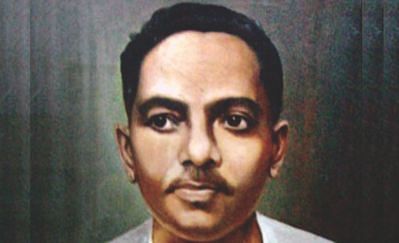Jibanananda Das, the foremost figure of surrealism

In the latter half of the 20th century, Jibanananda Das emerged as the most popular poet of modern Bengali literature. His unfamiliar poetic articulation, choice of words and thematic preferences took time to reach readers' hearts. He was also known as a surrealist poet because of his spontaneous, frenzied overflow of the subconscious in poetry and especially in diction. The poetry of Jibanananda has become the defining essence of modernism in twentieth century Bengali poetry.
February 17 marked the 114th birth anniversary of the poet.
Jibanananda was born on February 17, 1899 in Barisal, then East Bengal. His ancestors came from the Bikrampur region of Dhaka district. Jibanananda's father Satyananda Das was a schoolteacher, essayist and a publisher. His mother Kusumkumari Das was a poet. Jibanananda was the eldest son of his parents, and was called by the nickname Milu.
His school life passed by relatively uneventfully. In 1915, he successfully completed his Matriculation exams from Brajamohan School and two years later, completed Intermediate from Brajamohan College.
Later, he enrolled in Presidency College, Calcutta and graduated with a BA (Honours) in English Literature in 1919. The same year, his first poem appeared in print in the Baishakh issue of Brahmobadi journal.
When Deshbandhu Chittaranjan Das died in June 1925, Jibanananda wrote a poem called “Deshbandhu'r Prayan-eâ€, which was published in Bangabani magazine. This poem would later take a place in the collection called “Jhora Palok†(1927). His poetry began to be widely published in various literary journals and little magazines in Calcutta (now Kolkata), Dhaka and elsewhere. These included Kallol, perhaps the most famous literary magazine of the era, Kalikalam, Progoti and others. At this time, he occasionally used the surname Dasgupta as opposed to Das.
In 1935, Jibanananda, by now familiar with professional disappointment and poverty, returned to his alma mater Brajamohan College. He joined as a lecturer in the English department. In Calcutta, Buddhadeb Bose, Premendra Mitra and Samar Sen were starting a brand new poetry magazine called Kobita. Jibanananda's work featured in the first issue of the magazine, a poem called “Mrittu'r Aageyâ€.
Young Jibanananda fell in love with Shobhona, daughter of his uncle Atulchandra Das, who lived in his neighbourhood. He dedicated his first anthology of poems to Shobhona without mentioning her name explicitly. The poet, however, married Labanyaprabha Das in 1930. A clash of personalities erupted and Jibanananda gave up all hope of a happy married life. The estrangement with his wife never ended.
Das' notable poetic works are “Jhora Palokâ€, “Dhushor Pandulipiâ€, “Bonolota Senâ€, “Mohaprithibiâ€, “Shaat-ti Tarar Timirâ€, “Shrestho Kobita†and “Ruposhi Banglaâ€.
On October 14, 1954, he was unmindfully crossing a street near Calcutta's Deshapriya Park, when he was hit by a tram; Jibanananda was returning home after his routine evening walk. Seriously injured, he was taken to Shambhunath Pundit Hospital. Nonetheless, the injury was too fatal to redress. Jibanananda died in hospital on October 22, 1954 after eight days of struggle with death. He left behind his wife, a son and a daughter, and an ever-growing band of readers.
Compiled by Correspondent

 For all latest news, follow The Daily Star's Google News channel.
For all latest news, follow The Daily Star's Google News channel. 



Comments